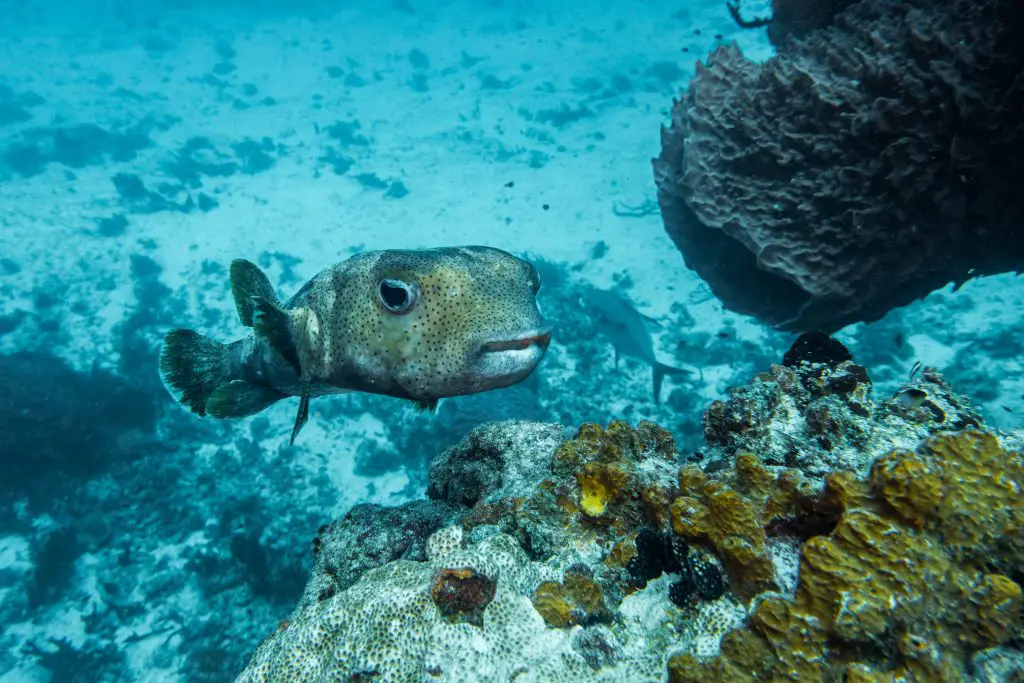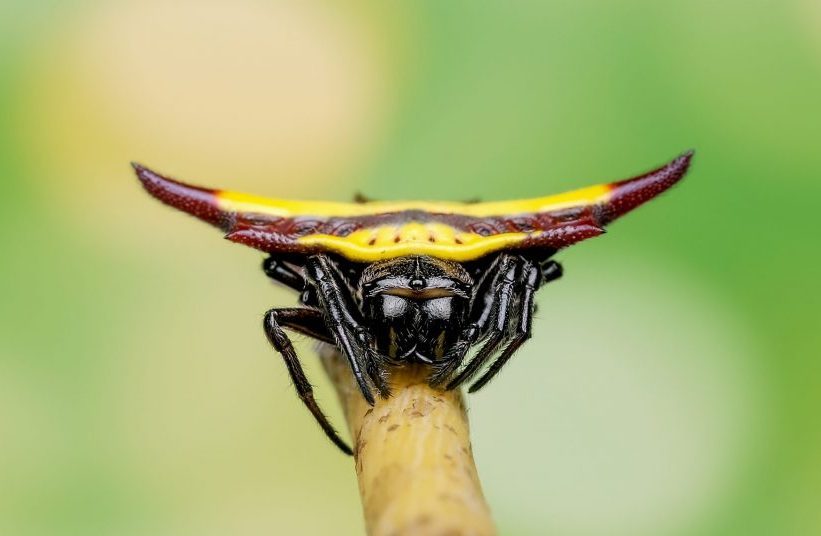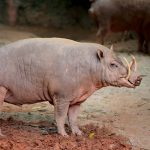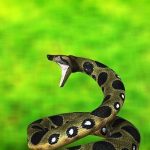Spiked animals are well-known for their abilities to protect themselves. Throughout the animal kingdom, we may witness a range of powerful and often odd self-defense strategies.
Carrying spines is an important defensive method against the opponent. Attacking these thorny animals is pretty tough.
In actuality, we humans are very ill-equipped for defense in the natural food chain, although our cognitive design and use of tools successfully compensate for our lack of body armor, venom, and claws. All of these bristly creatures have one thing in common.
1. Thorny Devil
- Scientific Name: Moloch horridus
- Type of Animal: Reptile
- Diet: Carnivore

The thorny devil is a tiny Australian native lizard that may grow up to 20 centimeters in length. It is found only in Australia. Mountain Devil is another moniker for this strange monster that has been given to it.
Prickly spikes cover the entirety of its body, acting as a deterrent to predators who might otherwise attack it. Because of the spiky spines on the Thorny devil’s body, predators find it difficult to consume it.
One further unusual aspect of this spiky species is the existence of a false head on one of its heads. When it detects danger or feels frightened by other animals, it lowers its head quickly and then reveals its false head to the audience.
The Thorny Devil is a well-known anteater that consumes thousands of ants every day, making him one of the most dangerous creatures on the planet. Most of the time, they may be found in Australia’s deserts.
Females are much larger than males. Wild birds and goannas are their primary predators, and they may live for up to 15 to 20 years with relative ease.
Mountain Devils are fascinating creatures, with spikes and the ability to change color on their bodies. During warm weather, it exhibits faint hues, which darken to reveal richer colors during cold weather.
2. Porcupinefish
- Scientific Name: Diodon hystrix
- Type of Animal: Fish
- Diet: Carnivore

Known by a number of names, including balloonfish, blowfish, globefish, and pufferfish, this spiny fish is found in the ocean. A medium- to large-sized fish prefers shallow water to dwell.
Only a handful of its species are capable of growing to a height of 90 cm. This spiky species possesses an unusual characteristic: it has the ability to enlarge its body by ingesting water or air.
The animal’s size is increased as a result of this process, making it more resistant to predators. It is the ninth most intriguing creature with spikes on our list of the most fascinating species with spikes.
Sharp spines are also found, and they play an important role in the protection of animals. As the fish gets inflated, the spines on its back begin to extend outwards.
Some of its species are poisonous, making them particularly efficient against adversaries. They carry a poison in their internal organs that are 1200 times more strong than cyanide, which makes them very dangerous. It is possible for several types of bacteria present in a fish’s diet to produce this toxin.
The porcupinefish has three extraordinary and powerful defensive systems that protect it from predators. As a result, only a few predators prey upon them. Sharks and killer whales are known to take the lives of adults on occasion.
3. Spiny Oakworm Moth
- Scientific Name: Anisota stigma
- Type of Animal: Insects (Caterpillar)
- Diet: Carnivore

The gorgeous white spots on the wings of these exquisite fuzzy moths’ wings serve as their one-of-a-kind fake eyes. In their early stages, caterpillars that eat the leaves adorn the spikes.
Despite its intimidating appearance, it is perfectly harmless. As hinted by the name, oak leaves are their favorite source of nutrition. They’re originally from North America. The larvae of this bug feed on oak, hazel, and basswood, among other trees.
4. Sea Urchins
- Scientific Name: Echinoidia
- Type of Animal: Marine Invertebrates
- Diet: Herbivore

Sea urchins are a spiky species that may be found in oceans all around the world, and they have a venomous bite. There are around 950 different species on the seabed.
Three to ten centimeters in length, the spiny, spherical tests of this species can grow to be rather long. Their largest species may grow to be 36 centimeters in length.
Sea Urchins are slow crawlers who move about by using their tube feet to propel themselves. They will occasionally utilize the spines of their bodies to help them in propelling themselves.
Sea Urchins are one of the most intriguing species on the planet, and they have spikes on their bodies. They like algae, although they will also devour slow-moving or sessile organisms if they can get their hands on them.
Sea otters, wolf eels, triggerfish, and starfish are some of the predators that live in the ocean.
5. Armadillo Spiny Tailed Lizard
- Scientific Name: Ouroborus cataphractus
- Type of Animal: Mammals
- Diet: Carnivore

Its natural habitat is on the Western coast of South Africa, where it may be found. The hue of the body can range from light brown to dark brown.
In addition to having a distinctive look, it features a yellow underside with a blackish pattern. Its overall length and width range between 7.5 and 9 cm. In total length, the Armadillo Spiny Tailed Lizard may grow to a maximum of 10.5 cm in length.
This lizard enjoys consuming spiders and insects, which are invertebrates that are small in size. When presented with a threat, they have an unusual characteristic in that they can easily curl up into a ball and conceal themselves in this manner.
This will aid them in their efforts to fend off predators. The thick, squarish scales on its back and the sharp spines on its tail, which serve as a deterrent to them, frighten predators.
6. Armored Rat
- Scientific Name: Hoplomys gymnurus
- Type of Animal: Rodents
- Diet: Omnivore

They have a significant number of spines on the back and sides of their bodies, which distinguishes them from other rodents in Latin America.
The length of these massive spines is 33 millimeters. It has a reddish-brown coloration on top and a pure white underbelly.
The Armored Rat has a similar appearance to Tome’s Spiny Rat, with the exception of having smaller eyes and a longer snout.
Fruits, green plant matter, and insects are among the foods that this spiny rat enjoys. During the first month of life, they are born with soft hair that eventually transforms into spines.
7. Echidna
- Scientific Name: Tachyglossus aculeatus
- Type of Animal: Mammals
- Diet: Carnivore

Spiny anteaters, sometimes known as echidnas, are found in Australia and New Guinea, where they are a common sight.
Ants and termites are among the insects that they enjoy eating. It is by the use of their lengthy, sticky tongues that they capture their prey.
There are little spines on the back of their tongue, which are prickly. Because echidnas lack teeth, they must break down their food by crushing it between the bottoms of their jaws and the tips of their tongues.
8. Crown of Thorns (Starfish)
- Scientific Name: Acanthaster planci
- Type of Animal: Fish
- Diet: Carnivore

A huge starfish preys on coral polyps that are solid or stony in nature. Throughout the creature’s whole upper surface, there are spines.
This term is given to it because of the lethal thorn-like spines that cover its body. The largest starfish, without a doubt, is one of the most stunning spiky organisms on the planet.
Coral reefs may be found all across the Indo-Pacific region, and they are particularly common in the Philippines. In addition, it has the potential to ingest vast amounts of coral.
9. Porcupine
- Scientific Name: Erethizon dorsatum
- Type of Animal: Rodents
- Diet: Herbivore

In order to defend itself, the porcupine, whose name comes from the Latin words for pig and spine or quill, is covered with up to 30,000 needle-like quills, which may be instantly fired when it is assaulted.
Porcupines are huge rodents with sharp spines or quills on their coat, which they use to defend themselves. These spines serve to protect them from predators.
10. Hedgehog
- Scientific Name: Erinaceus europaeus
- Type of Animal: Mammals
- Diet: Carnivore

The hedgehog is at the top of the list of intriguing species with spikes because of its unique appearance. This spiky species’ food includes insects, roots, berries, snails, and frogs, among other things.
These nocturnal insects are distinguished by their defensive ball-curling stance, which contains up to 6,500 spines and is used to defend themselves. They hibernate throughout the winter months in cooler areas.
11. Whiptail Stingrays Sting
- Scientific Name: Dasyatis americana bonaire
- Type of Animal: Fish
- Diet: Carnivore

Two small, lethal harpoons are attached to the end of its tail. Which gives The whiptail stingray its name.
Scorpionfish, lionfish, and stonefish, as well as around 250 other species of fish, are venomous and have horrendous spikes.
They have poison stings on the dorsal fins of their bodies, as well as spines on the ends of their bodies.
12. Cone Snail
- Scientific Name: Conus geographus
- Type of Animal: Marine
- Diet: Carnivore

Despite the fact that the cone snail does not have pointed ears and does not live in Rivendell, it is one of the sea’s most feared archers.
The harpoons they use are poisonous, and they are discharged straight from their lips, so anyone who goes too close will be exposed. The barbs become entangled in the prey, causing it to become paralyzed by the extremely concentrated nerve toxin.
Next comes the horrible part: the cone snail swallows its prey whole, including the skin and hair, as well as the flesh. It’s also equally as quick as Legolas: if one arrow isn’t enough, it just shoots another at the same time.
As a result, if you come across a live cone snail on the beach, proceed with extreme caution. The toxin may pose a threat to human health. It is so lethal that it is possible to die because of it. Please don’t get your hands on it!
13. Spiny Orb-Weaver
- Scientific Name: Gasteracantha cancriformis
- Type of Animal: Spider (Arachnids)
- Diet: Carnivore

It can be found all over the world, including in the United States, California, and Florida, and is also known as the spiny orb-weaver or the spiny spider.
Araneidae spiders are also known as The Spiny Spider because of their spiny backs. In addition to having six distinct spines on their huge, robust abdomens, they also have brilliant colors, which are particularly evident on female spiders.
Because of their spines, colors, and durable body shells, they are similar in appearance to a crab spider.
Female spiny-backed orb-weavers are noticeably larger and more colorful than their male counterparts, which is surprising given their small size.
14. Lionfish
- Scientific Name: Pterois volitans
- Type of Animal: Fish
- Diet: Carnivore

One of the most dangerous marine fishes on the planet is the lionfish. Also known as the fire fish, turkey fish, or butterfly cod, this poisonous fish may be found in the Indo-Pacific, the Red Sea, and other oceans.
It is a member of the genus Pterois of the family Scorpaenidae. Their spines and toxic pectoral fins distinguish these fishes, which may be found in a range of colors including red, white, and creamy.
In all, there are around 18 venomous spines. Two pelvic spines, three anal spines, and thirteen dorsal spines are among the bones that make up the skeleton.
Despite its vibrant coloration and contrasting stripes, it is a good target for predators because of its brightly colored spines.
Predators, like sharks, may feast on these fish without being harmed by the toxic spines of lionfishes, which are found on their bodies.
15. Western Saharan spiny mouse
- Scientific Name: Acomys airensis
- Type of Animal: Rodent
- Diet: Omnivore

A little rodent may be found in the Niger River valley, southern Mauritania, Mali, Chad, the Western Sahara, and Algeria. It is a member of the mouse family.
On the back of their necks, they have a snarl of spiky hair that is part of their distinctive fur. These spikes, or prickly hairs, are not as strong as those found in hedgehogs, but they are relatively hard and are strategically placed on their delicate skin, giving some protection from predators in particular situations.
Although most mice, particularly house mice, have elastic skin, the Western Saharan spiny mouse’s skin
16. Spot-fin Porcupinefish
- Scientific Name: Diodon hystrix
- Type of Animal: Fish
- Diet: Omnivore

It is also known as the spot-fin porcupinefish, spotted porcupinefish, or black-spotted porcupinefish, and it is a Mediterranean Sea fish belonging to the genus Diodon and the family Diodontidae.
It may be found in the Mediterranean Sea. They have scales on their bodies that have been changed into spines or spine-like spikes.
When they feel threatened, they will ingest water to inflate their bodies and erect their spines, which are found all over their bodies, to protect themselves.
Predators find it difficult to devour them because of their upright and sharp spines all over their bodies, which may also cause injury to intruders.
17. Three-Spine Stickleback
- Scientific Name: Gasterosteus aculeatus
- Type of Animal: Fish
- Diet: Carnivore

In the genus Gasterosteus and the family Gasterosteidae, the three-spine stickleback is a kind of fish that has three spines on each side of its body.
Throughout the Northern Hemisphere, including the Arctic Ocean, it may be found in brackish and marine areas, as well as freshwater habitats.
They have three spines in front of their dorsal fin, which helps to protect them from predators. The third spine, which is located near the dorsal fin and is shorter than the previous two, is located near the dorsal fin.
This creature possesses a membrane linking its spines, which helps to ensure that all of the spines are erected at the same time.
All of the spines are designed to deter or prevent their predators from eating them, which is surprising considering how common this is.
18. Spiny Flower Mantis
- Scientific Name: Pseudocreobotra Wahlbergi
- Type of Animal: Mantis (Hymenopodidae)
- Diet: Carnivore

The spiny flower mantis is a unique insect found throughout the tropical regions of the world. Unlike many other types of mantis, which are relatively smooth and flat, the spiny flower mantis has numerous sharp, pointed spikes covering its body.
These spikes not only make it difficult for predators to attack and kill the mantis, but they also help to grip and manipulate prey items.
The spiny flower mantis typically inhabits forests and other humid tropical environments, where it can quickly hide in flowers or beneath fallen leaves to avoid detection.
Due to its unique arboreal lifestyle, this insect has developed highly sensitive eyes that can detect even the smallest movements from above or below.
It uses these visual cues to track down prey, pouncing on unsuspecting insects like flies, crickets, and other small invertebrates with lightning-fast movements.
Despite its fearsome appearance and defensive tactics, the spiny flower mantis is actually quite an intriguing animal that is essential to maintaining the ecological balance in its native habitats.
Are Animals with Spikes or Spines More Likely to Have Down Syndrome?
Are animals with down syndrome more likely to have spikes or spines? This topic may seem unusual, but it’s important to note that down syndrome is a genetic disorder found in humans. As such, it does not affect animals, and they cannot be categorized as animals with down syndrome. However, some animals do have spikes or spines as a natural defense mechanism.
19. Spiny Leaf Insect
- Scientific Name: Extatosoma tiaratum
- Type of Animal: Insect – Phasmatidae
- Diet: Herbivore
- Also Known As: Spiny leaf insect – the giant prickly stick insect – Macleay’s spectre – the Australian walking stick

The spiny leaf insect is a fascinating creature with striking, spiny body parts that serve several important functions.
Its distinct morphology allows it to effectively ward off predators and protect its eggs from harm, while also helping to regulate insect temperature and humidity levels.
This insect thrives in warm, damp environments and can be found in tropical rainforests in northern Australia.
Despite their intimidating appearance, these insects are not dangerous to humans and actually play an important role in maintaining the health of trees and other plant life in their native habitats.










